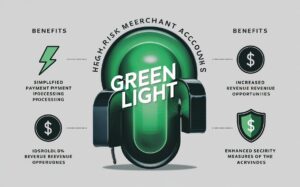Introduction:
High-risk merchant accounts play a crucial role in enabling businesses operating in industries deemed risky by traditional financial institutions to accept payments securely and efficiently. Understanding the approval process for these accounts is essential for businesses seeking to navigate the complex landscape of payment processing.
In this guide, we’ll delve into the intricacies of the approval process for high-risk merchant accounts, shedding light on the key factors that influence approval decisions and providing valuable insights for businesses aiming to secure these accounts.
- What Are High-Risk Merchant Accounts?
High-risk merchant accounts are specialized payment processing solutions designed to cater to businesses operating in industries that are considered riskier than others by payment processors and financial institutions. These accounts are characterized by higher levels of chargebacks, fraud, and regulatory scrutiny.
Businesses in industries such as adult entertainment, online gaming, CBD products, and nutraceuticals are often classified as high-risk due to the nature of their operations. Additionally, businesses with poor credit histories or those with a high volume of transactions may also fall into this category.
- Why Do Businesses Need High-Risk Merchant Accounts?
Businesses operating in high-risk industries face a myriad of challenges when it comes to payment processing. Traditional financial institutions are often hesitant to provide merchant accounts to these businesses due to the perceived risks involved. As a result, businesses in high-risk industries may struggle to find payment processing solutions that meet their needs.
Having access to specialized high-risk merchant accounts is essential for these businesses to accept payments from customers securely and efficiently. Without such accounts, they may face limited options for payment processing or may be forced to rely on less reputable payment processors that charge exorbitant fees or offer inadequate fraud protection.
By leveraging high-risk merchant accounts, businesses can overcome the challenges associated with operating in risky industries and ensure seamless payment processing for their customers.

Understanding the Approval Process:
The approval process for high-risk merchant accounts involves several steps aimed at assessing the business’s viability and mitigating potential risks for payment processors and underwriters. These steps typically include:
- Application Submission: Businesses interested in obtaining a high-risk merchant account must first submit an application to a payment processor or acquiring bank. This application provides essential information about the business’s operations, financial history, and anticipated transaction volume.
- Underwriting Review: Once the application is submitted, it undergoes a thorough review by underwriters who assess the business’s risk profile. Underwriters evaluate factors such as the industry in which the business operates, its financial stability, and its history of chargebacks and fraud.
- Risk Assessment: Underwriters analyze the risk associated with providing payment processing services to the business. They consider factors such as the potential for high chargeback rates, the likelihood of fraudulent transactions, and the regulatory compliance of the business’s operations.
- Due Diligence: Underwriters may conduct additional due diligence, such as verifying the business’s identity, reviewing financial statements, and assessing the business’s compliance with industry regulations.
- Approval Decision: Based on the information gathered during the underwriting process, the payment processor or acquiring bank makes an approval decision. If approved, the business is granted a high-risk merchant account, allowing it to accept payments from customers.
Documentation Requirements:
Obtaining a high-risk merchant account requires businesses to provide various documents to support their application. Commonly required documents include:
- Business Registration: Proof of business registration, such as articles of incorporation or a business license, is typically required to verify the legality and legitimacy of the business.
- Financial Statements: Businesses may need to provide financial statements, including balance sheets, income statements, and cash flow statements, to demonstrate their financial stability and ability to fulfill payment obligations.
- Processing History: Payment processors may request information about the business’s processing history, including previous merchant account statements and transaction volumes, to assess its risk profile.
- Compliance Documentation: Businesses operating in regulated industries may need to provide compliance documentation, such as licenses, permits, or certifications, to demonstrate their adherence to industry regulations.
Providing accurate and complete documentation is crucial for a successful application process. Inaccurate or incomplete information can delay the approval process or result in a denial of the application.
Factors Affecting Approval:
Several factors influence the approval decision for high-risk merchant accounts. These factors include:
- Industry Risk: Businesses operating in high-risk industries, such as adult entertainment, online gaming, or nutraceuticals, may face greater scrutiny during the approval process due to the inherent risks associated with these industries.
- Financial Stability: Payment processors assess the financial stability of the business to ensure that it can fulfill its payment obligations and manage potential chargebacks and refunds effectively.
- Chargeback History: A history of high chargeback rates can negatively impact the approval decision, as it indicates a higher risk of financial loss for the payment processor.
- Compliance with Regulations: Businesses must demonstrate compliance with relevant regulations, such as anti-money laundering (AML) and know your customer (KYC) requirements, to obtain approval for a high-risk merchant account.
To increase the chances of approval, businesses should ensure that they provide accurate and comprehensive information in their application, maintain a stable financial position, and implement measures to minimize chargebacks and fraud.

Common Reasons for Rejection:
Despite efforts to obtain a high-risk merchant account, applications may sometimes face rejection. Common reasons for rejection include:
- Incomplete or Inaccurate Information: Providing incomplete or inaccurate information on the application can lead to rejection. It’s essential to ensure that all required fields are filled out accurately and honestly.
- High Chargeback Rates: High chargeback rates signal potential financial risks for payment processors. Businesses with a history of excessive chargebacks may find it challenging to obtain approval for a high-risk merchant account.
- Poor Credit History: Payment processors may review the business owner’s credit history as part of the underwriting process. A poor credit history or previous bankruptcy filings could negatively impact the application’s approval chances.
- Lack of Compliance Documentation: Failure to provide necessary compliance documentation, such as licenses or permits for regulated industries, can result in rejection. Businesses must ensure they have all required documentation in place before applying.
To address and overcome potential issues leading to rejection, businesses can take the following steps:
- Conduct a Comprehensive Review: Before submitting an application, businesses should review all provided information to ensure accuracy and completeness. Address any discrepancies or missing details to prevent potential rejection.
- Address Chargeback Concerns: Businesses with high chargeback rates should implement strategies to reduce chargebacks, such as improving customer service, implementing fraud prevention measures, and offering clear refund policies.
- Improve Credit History: If poor credit history is a concern, business owners can take steps to improve their credit scores, such as paying off outstanding debts, maintaining low credit card balances, and disputing inaccuracies on credit reports.
- Obtain Necessary Compliance Documentation: Ensure that all required compliance documentation is readily available and up to date. This may involve obtaining licenses, permits, or certifications specific to the industry in which the business operates.
By proactively addressing these common reasons for rejection, businesses can increase their chances of obtaining approval for a high-risk merchant account.
Tips for a Successful Application:
To submit a successful application for a high-risk merchant account, businesses should consider the following tips:
- Choose the Right Provider: Research and choose a reputable payment processor with experience in serving high-risk industries. Look for providers that offer transparent pricing, reliable customer support, and robust fraud prevention measures.
- Prepare Documentation: Gather all required documentation, including business registration documents, financial statements, processing history, and compliance documentation. Ensure that all documents are accurate, up to date, and readily accessible for submission.
- Provide Accurate Information: Fill out the application form accurately and honestly, providing detailed information about the business’s operations, products or services offered, and anticipated transaction volume. Transparency is key to building trust with the payment processor.
- Communicate with the Provider: Maintain open communication with the payment processor throughout the application process. Address any questions or concerns promptly and provide additional information or clarification as needed.
- Be Patient and Persistent: The approval process for high-risk merchant accounts may take longer than traditional merchant accounts. Be patient and follow up with the payment processor regularly to check on the status of your application.
- Consider Professional Assistance: If navigating the application process seems daunting, consider seeking assistance from payment processing consultants or legal experts specializing in high-risk industries. They can provide valuable guidance and support to help streamline the application process.
By following these tips, businesses can increase their chances of submitting a successful application for a high-risk merchant account and obtaining approval from the payment processor.
Conclusion:
In conclusion, understanding the approval process for high-risk merchant accounts is essential for businesses operating in industries deemed high-risk by payment processors and underwriters. By familiarizing themselves with the common reasons for rejection, addressing potential issues, and following tips for a successful application, businesses can navigate the approval process more effectively. Obtaining a high-risk merchant account opens up opportunities for businesses to accept payments from customers in high-risk industries and regions, enabling growth and expansion in competitive markets. As businesses continue to evolve and adapt to changing regulatory landscapes and consumer preferences, having a reliable payment processing solution tailored to their needs becomes increasingly crucial. By prioritizing transparency, compliance, and communication throughout the application process, businesses can position themselves for success in the high-risk payment landscape.
